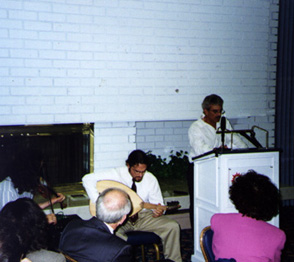
By Jacqueline Arikian
Armenians. A group of people whose stories are a reflection of their suffering and survival throughout time. A group of people whose wars, according to William Saroyan, “have been fought and lost, whose structures have crumbled, whose literature is unread, whose music is unheard, and whose prayers are no more answered.” On the evening of November fifth, on the campus of California State University Fresno, during the honoring of Dr. Dikran Kouymjian at the Armenian Studies Banquet, the music of the Armenians were heard loudly and their poetry was read passionately.
We listened to the traditional Armenian music played by Michael Baloian and Hemmy Bluestein, as we sat there, mesmerized at the recreation of the Armenian spirit, the spirit that lurked within each of us on a different level and a music we heard which reminded us of the many stories that we had been told, the stories of death, torment, and beauty. And to a certain extent, we all found ourselves relating to it, recalling fragments told by our relatives or pieces of it presented in our Armenian classes. Somehow, in some way, we each found our connection as we heard the mellow music speak to us in the background.
As the music danced on stage, the words of the poet, Jim Baloian, verbalized our feelings. With each word that he spoke, with each emphasis and escalation in his voice, his passion vibrated throughout the room, bouncing off the walls, making itself known to the world, a world who knew. It was not difficult to understand the Armenian message behind Baloian’s poems, for each word spoke of a truth, one which we all knew and understood.
We listened to the reflections of Armenia’s beautiful land, of its people, and its customs. And as Baloian paused, the look in his eyes and his very being created an Armenia in itself, an Armenia which broke the serene vision in our imagination.Looking around the room, I saw the applause in the eyes of the audience. I knew that they were feeling the intensity of Baloian’s reflection of Armenia and Armenian life. They listened, laughing with him and hurting with him, feeling the stabbing wounds of those before them. Through Baloian, they saw the fire of what they had known for so long.
There was no need for explanation, Baloian’s presence said enough. Watching his hands firmly grip the sides of the podium as he briefly looked up from his ignited words, the vibration of his gestures helped to explain. As the poem concluded, they all reinforced him through their friendly faces and applause, illustrating their unity loudly and encouragingly, anxiously awaiting for the next recreation.
Modestly, Baloian fed them, recreating what they were awaiting. The music in the background emphasized the visions. With each note the musicians played, the audience absorbed within themselves, releasing the bottled passion through their cheers. And so this cycle continued, with each new poem and each new song adding to the completion of the puzzle.
On that evening, each person entered into the banquet room with their own heartaches and their own individualistic qualities, a commonality of Armenianess bringing them together. Unknowingly, each piece came together, feeding off of each other, and for a brief moment in time, unifying the Diasporic puzzle. As these Armenians came together, living through Baloian’s words and feeling the Armenian music, they reiterated Saroyan’s point by creating a New Armenia.
 Hye Sharzhoom Armenian Action
Hye Sharzhoom Armenian Action